My 'occasional player level,
class D' chess computers
Fidelity
Sensory
Chess Challenger 6
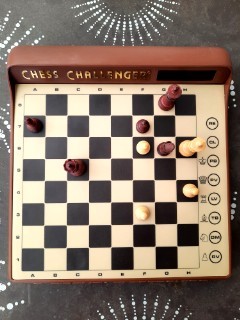
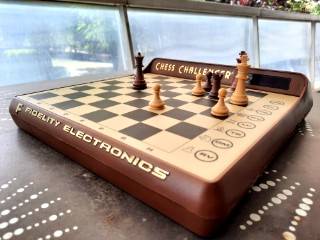 Year:
1982
Programmer: Ron
Nelson
Year:
1982
Programmer: Ron
Nelson
CPU: 8048
@11Mhz
ROM:
4Kb
Elo level:
1212 (1300
FIDE)
CMhz: 0.85
Rperf: 73%
Square size: 1"
A
relatively insignificant electronic chessboard, as it succeeded the
Sensory 8 displayed in this page (see below), at a lower cost at the
expense of removing the diods on squares, replaced by a reduced display
(only two LED characters, while a CC7 for example displays four of
them), featuring a weaker processor and less playing levels to choose
from... Nevertheless, a few small enhancements including a slightly
larger openings book (but still embryonic), and enablement to
display a hint move, and also to take back two half-moves. The program
is placed in a removable cartridge, but Fidelity never offered any
stronger play module; only a "book openings" one for classic openings
practice, and a "greatest games" module for master games study. By the
way, both modules were as well available for the Mini Sensory (see
previous category), but used different references: the cartridges were
not compatible (!). To make it short, the modular feature was quite
useless for such mass market devices, by
design limited by
their low-end CPU. Indeed the playing level weakened with regards to
the Sensory 8, but is ahead of the Mini Sensory+CAC, mainly thanks to a
faster clocking. So, little reasons to add this one to my collection...
but opportunity: €5 on french "le bon coin", mint condition,
complete with the original mains adapter and set of pieces, the small
user guide like new, and the original packaging. How would you resist?
And to be fair, without any protuberant LED on the board, it is a clean
looking chess computer.
VEB RFT
Chess-Master Diamond
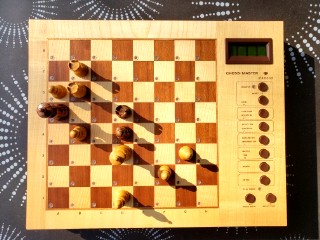
 Year:
1987
Programmer:
Rüdiger Worbs & Wolfgang Pähtz
Year:
1987
Programmer:
Rüdiger Worbs & Wolfgang Pähtz
CPU: U880 @4Mhz
ROM: 16Kb
Elo level: 1231 (1315
FIDE)
Elo level with
PM11: 1283 (1354
FIDE)
CMhz: 1.35
Rperf: 72% (with
PM11: 75%)
KT: 1134 (with PM11: 1171)
Square size: 1.38"
The
Chess-Master Diamond is the ultimate evolution of RFT VEB
Mikroelektronik Erfurt products, from the former East Germany. If the
processor is still a copy of the Zilog Z80 (U880), it runs notably
faster than the SC2 one (displayed in the previous category), featuring
4Mhz instead of 2.5Mhz. It is a still more massive (weighting
around 4kg!) chess
computer than the SC2, despite not including a transformer (the power
source is an external mains adapter); as it is made of wood, and of
imposing size. Everything is pretty large: the chessboard squares (1
3/8 inches
sides), the control panel, the display (3 1/8 inches, including the
surround!). To realize how much it is nice and impressive, you need to
see it in real life, pictures are not enough. Mine deserves no value
for collection, as only the electronic chessboard (and its cardboard
box) are original: the mains adapter is a modern one, the set of pieces
is not the original one, and the optional modules are missing. The
offerred pieces were part of my decision to buy; the former owner had
chosen them with great taste, as they are VERO chessmen from the former
GDR (which is a consistent choice), they are much nicer than the
original ones; and I do love their design - I had already purchased a
similar set to better fit out my King Performance. He bought this set
€50 (I trust him, I bought mine €49.90!) and adapted
the required magnets to let the sensitive board detection work. Total
cost €58 including the set of magnets; I payed €150
for the whole lot; that is to say €92 for the chess computer
itself, including the adapter; in mint working and cosmetic condition.
The price seemed deserved to me, and it was! As you surely
understood, the board is an auto-response one, detecting the moves
thanks to Hall effect sensors. With regards to the thickness of the
wooden board, the inserted magnets (South pole below) have to be
strong. The program shows its own moves using one LED in each square,
the from-square permanently lightened, the to-square blinking. By
default, the display shows who is on the move ("Y" for
"You", else "C" for "Computer"), but shows alike which side
(up or down arrow) - and possibly additional information, such
as
'+' to announce a check situation, or 'MATE' if so. But you can set the
display to show, according to your preference, any one from a
bunch of other data. You can choose to display the played move, the
move number, or the computer score, or the depth of computation, or any
of the many available informations. Of course you can browse thru all
those, and the last displayed one, before resuming playing, will stay
enabled from then on. Simple and convenient! In addition to displaying
information, the offered features are many, sometimes advanced. In an
article for the 'Modul' magazine published in January 1989, Thomas
Mally summed it up this way: 'a high technology dinosaur, with features
from today, in a dressing from
yesterday, with a
program from the day before'. Actually, the level of play is weak,
despite enhanced with regards to the preceeding devices from this
brand! The computer includes a connector to enable inserting an
external module, two were offerred: PM10 ("opening module", 8K)
containing a library of openings, and PM11 ("endgame module", 16K)
providing enhanced algorithms. I will get back to the importance of
these with detailed comments, leveraging the Khmelnitsky test outcomes.
The lack of PM10 openings module could indeed be a concern, as the
basic program computes as soon as its first move; this could result in
always the same moves to be played, assuming same thinking time. Well,
as a good demonstration of the extensive features, those can solve this
point: the program offers a "BEST" setting to always choose the move
with the highest score, if enabled; or provide more variety based on a
random choice among the best moves, if disabled. I experienced
playing openings with BEST disabled, four moves using this mode are
enough to get a diversity of variants at least equivalent to a small
library featured by a Chess Challenger 6 or 7, and after five to six
moves played, the variety of games is more than enough. I use this mode
combined with the display of the move number, and I enable again the
BEST mode before inputing my sixth move. So, openings variety, then
optimal moves (everything is relative)!


As
an actual outcome, the module displays a more balanced profile, more
rounded, achieving a higher global score with 37 more Elo points (thus
1171). To help sizing the difference: on a statistical basis, assuming
twenty games played, a 1200 Elo player wins 12 of them against the
basic program, while winning 11 against the PM11 module... Obvious
gains relate to spotting sacrifices, and tactics. Both middlegame and
defense profit from the module, with close to 90 Elo points more.
Endgame is only enhanced in standard positions (nevertheless +60 Elo
points). Otherwise, the additional focus applied to these domains
lowers the crest of strength for opening and counterattack, which does
not matter much, considering the wide margin available compared to the
average level of play. The loss in the strategy domain (-74 Elo points)
is on the other hand sort of a pity.
(*)
Three months after I wrote these lines, I had an opportunity to
purchase a PM11 module; it was offered on eBay, buy it now and priced
€49.
Fidelity
Chess Challenger 7
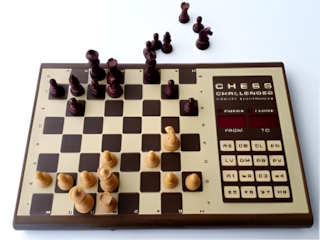
 Year:
1979
Programmer: Ron
Nelson
Year:
1979
Programmer: Ron
Nelson
CPU:
Z80 @3.6Mhz
ROM:
4Kb
Elo level:
1259 (1336
FIDE)
CMhz:
1.21
Rperf:
74%
Square size: 0.87"
My
very first one! Bought brand new once available... Then bought again
about thirty years later for €45. This device made electronic
chess affordable for most ones. The design is restrained and pleasant,
despite being fully plastic made. The animated while thinking big red
LEDs display is nice, it helps granting the Chess Challenger some
personality (it seems to enter panic mode when put under pressure!).
Even pieces are nicely designed, to such a point I sometimes use it as
a passive chessboard. Playing level is weak, especially since I know
its play inside out...
Novag Chess
Champion Super System III

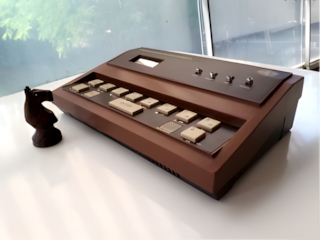 Year:
1979
Programmer: Mike
Johnson
Year:
1979
Programmer: Mike
Johnson
CPU:
6502 @2Mhz
ROM:
8Kb
Elo level:
1270 (1344
FIDE)
CMhz:
2
Rperf:
73%
A
high-end chess computer at that time, featuring a strong hardware
(2Mhz 6502), an advanced 8K program, expansion capabilities
with a
full chessboard LCD display and a printer; both can be plugged sideways
after removing plastic covers. Sophistication mostly concerns chess
features, not playing strength: under-promotion, 'en passant' capture,
draw rules including stalemate, three-fold repetition and 50-moves
rule,
instant display of selected piece once 'from' coordinates are input...
A very complete chess computer at that time, somewhat complicated to
use. Mike Johnson belonging to David Levy's team will also author the
Novag Chess
Champion
Pocket Chess / Chess Traveller (using 4Mhz Fairchild F8) and the Chess
Partner 2000. Playing level is set, such as the Boris, with a timer, to
the nearest second. I like it... The one I own, bought at a low price
(€20) on German eBay, featured a quite unreliable keyboard:
sometimes, randomly, a key input was erroneously scanned (for instance,
a 'B' displayed instead of a 'A', a '4' instead of a '6'...), however
carefully the key was hit (a brief or long press, a clear
split
between two hits, and so on...).
Maybe one input out of twenty to thirty required to be cleared and
restarted, this did not prevent playing but was uncomfortable. I
realized some day this issue completely disappeared when I set the time
switch to on. I used to play 'time off' to display the preferred move
during program thinking time; whereas 'time on' displays the remaining
time down to computer move. I faithfully get keyboard errors again
whenever I set 'time off', and 'time on' results in a never failing
keyboard scan! I do not know if this issue is specific to the SSIII I
own, or is commonly shared by other ones. It also happened to my SSIII
to be found stuck after leaving it a while (such as a quarter of an
hour) on but unused; while during continuous play I never encountered
such an issue.
Fidelity
Sensory Chess Challenger 8

 Year:
1980
Year:
1980
Programmer: Ron
Nelson
CPU:
Z80 @3.8Mhz
ROM:
4Kb
Elo level:
1282 (1353
FIDE)
CMhz:
1.28
Rperf:
75%
Square size: 1"
What
the hell is this Sensory 8 doing here? It plays accurately the same
moves as above CC7... Apart from an additional playing level (2 minutes
& 10 seconds average per move), it is actually the same
repackaged
program.
Yes it is, but... it was offered in one single batch with
the Mini
Sensory+CAC, for €35, a price I would gladly have agreed for
the Mini Sensory alone. Thus I look on it as a free bonus
gift!
And to be considered, it is the first Fidelity device featuring a
push-sensitive board, so despite being weak and mass market oriented,
this chess computer is no blot in a collection. For nostalgia's sake, I
prefer playing the CC7, despite the actual comfort of the sensitive
squares and LEDs.
Mein erster
/ My first / Mon premier / Mephisto
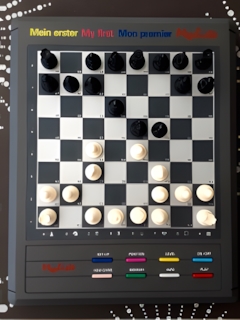
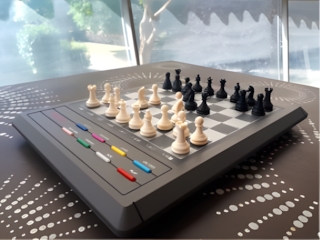 Year:
1991
Year:
1991
Programmer: Eric van
Riet Paap
CPU:
M50747 @8Mhz
ROM:
8Kb
Elo level:
1294 (1362
FIDE)
CMh
: 1
Rperf:
77%
Square size: 0.86"
I
got this chess computer as a gift, as a result of the interest I shared
regarding the Stadlbauer Maestro SchachProfessor (introduced
hereafter). The box is similar to the Mephisto Europa A one, made more
simple with less keys and featuring more attractive colors for kids,
and inside is the small 'Zen' 4K program from Eric van
Riet Paap, running on a Mitsubishi
microcontroller. As Kaare Danielsen did attract notice entering his 16K
6301Y microcontroller program in the 1986 world computer chess
championship, Eric
van Riet Paap succeeded in demonstrating his ability to program yet
smaller, in 1988, during the 8th Dutch open computer chess
championship, in Leiden, Netherlands. The podium gives an evidence of
the tournament level: winner Quest (later sold as Fritz), followed by
Rebel,
Kallisto, The King... The microcontroller Zen used, a M50743,
featured only 128 bytes RAM (256 for the M50747
powering the Mein Erster)! Despite Zen did not score any point during
this competition, Hegener & Glaser jumped at the opportunity to
complete the Mephisto series with small travel computers based on this
program and on this very same series of microcontrollers (Mephisto Mini
in 1989, soon to be followed by more). Actually the hardware is
limited, not the programmer: Eric
van Riet Paap did write worldclass Draughts and Awari programs, and his
chess program Genesis got a gold medal in 1992, in the 4th computer
games olympiads; tied with Hiarcs and The King, no less! The 'Mein
erster' (the brand being German, I privilege its name from Goethe's
language) includes, as the Maestro
SchachProfessor does, learning exercises (mini games) increasing its
ROM size to 8K, and a learning booklet with more than 90 pages is
provided (it includes instructions for using the computer, scattered
here and there amongst the lessons; so there is no actual user manual).
Thomas Mally, co-author of the booklet with Helmut Weigel, grants the
later one for the whole idea. I point out the exercises are different
from the Maestro
SchachProfessor's ones, and the graduating of difficulty is different
as well: the Mein erster scales difficulty using more thinking time for
the program as your opponent in mini games, while the Maestro
SchachProfessor plays evenly fast, but offering more or less
favourable starting positions (complexity being raised with allocating
more pawns to the computer). Played moves in a computer to computer
comparison show evidence that, with a four years gap, Zen program
versions slightly differ (in addition to the faster hardware used by
the Maestro
SchachProfessor). A nice
addition to my collection, thanks!
Yeno 320 XT
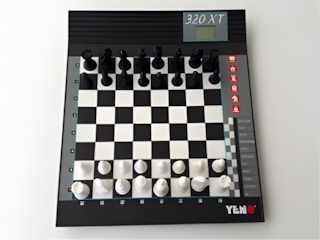
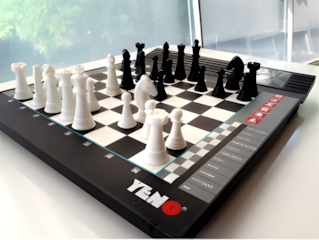 Year:
1994
Year:
1994
Programmer: Kaare
Danielsen
CPU:
68HC05 @2Mhz
ROM:
4Kb
Elo level:
1300 (1367
FIDE)
CMhz:
0.85
Rperf:
78%
Square size: 0.91"
I
was keen on entering in my collection the famous 4K program from Kaare
Danielsen. It has been very largely distributed under various brands,
so better choose a low cost Yeno (I bought it for €25) very
easy
to find in France (Yeno designed its production in France, before
having it built in China, and K. Danielsen points out travelling
to France in 1993 in order to adapt his 4K program for the
68HC05 microcontroller).
It is a low-end device designed for the general public, with pieces a
bit too large with regards to its size, thus difficult to handle
because of lack of room, without any LED - a small LCD displays in
sequence the 'from' square, then the 'to' one (such as Chess Challenger
6 does) and the control panel on the right is the poorest 'keyboard' I
know of (with pressure sensitive small white rectangles arranged in
zigzag). No real keys, one has to put the surface out of shape, for
instance with one's nail... Fortunately, the push sensitive chessboard
more intensively used is a bit hard but acceptable. The program
provides several playing styles and I had fun testing them to check
whether, for instance, aggressive was best for white, or defensive best
for black, or any other arrangement... As a conclusion, normal style
revealed the most efficient one. This small device is the first one
within this list to ponder on opponent's time (permanent
brain), though you wouldn't
think so to look at it.
Yeno 301 XL
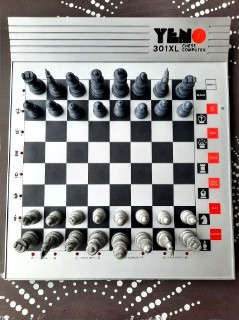
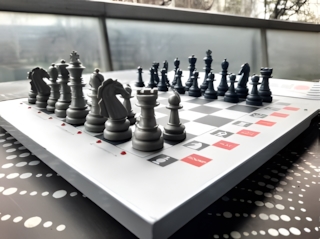 Year:
1988
Year:
1988
Programmer: Jon
Green (?)
CPU:
63B01X @8/4Mhz
ROM:
4Kb
Elo level:
1360 (1411
FIDE)
CMhz: 1.68
Rperf: 79%
Square size: 0.91"
The
very first Yeno: it came before the Yeno 532XL by a few months. You can
read about the 532XL in the strong chess computers page (class A
level). It shares its form factor with the 320XT, but the facturing
quality is far better, on par with the 532XL. Its processor (equivalent
to the more commonly known 6301Y) being close to twice as fast as the
320XT one, provides it yet another advantage. Identifying the
authorship of this
program remains unreliable: Jon Green is indeed named
by David Levy, but the program ROM grants the copyright to Bray. Within his business company, developping
chess programs for various clients, David Levy onboarded not only
reknown chess programs developpers (such as Mark
Taylor, David Broughton, Richard Lang, Mike Johnson,
Martin Bryant), but also programmers able to encode his algorithms on
various microprocessors and microcontrollers. Anyway, this very same
program powers as well two Chess King computers: the
1984 Triomphe
(clocked half as fast) and the 1987 Counter Gambit. It is a pleasant
opponent, even if somewhat weak, as it leverages balanded skills
including some positional abilities to develop its pieces, and some
tactical skills as well. Nothing to be feared by any
experienced player, but enough to resist and make you happy to
win. It has been sold using either of two sets of chessmen, most
probably according to the year of its production: those displayed here,
shared with the 532XL, rather original ones; or pieces that much look
like Saitek ones, and are probably later ones. Getting the original
pieces was part of my criteria when I decided to buy this one
(€29 on French eBay, boxed, shipment included thus
€24.90
without shipment). By the way, I like very much the distinctive design
of the pawn, for certain its "helmet crest" reminds me of Marvin, the
Looney Tunes small Martian.

"Bray" might refer to "Bray Research Ltd.", company that could have purchased the program license.
Mephisto 1X
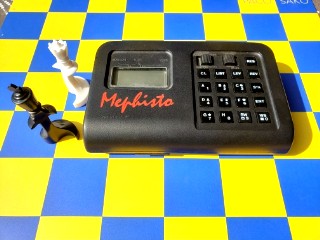
 Year:
1981
Year:
1981
Programmer: Thomas
Nitsche, Elmar Henne
CPU: 1802
@4.2Mhz
ROM: 12Kb
Elo level: 1368 (1418
FIDE)
CMhz: 0.54
Rperf: 84%
KT: 1171
At last I
succeeded in finding a Mephisto 1X! Should you read my comment
on the Mephisto II, next page, you would be aware I was actually
looking for the 1X by then; four years ago... This small chess computer
met an unexpected fate, brief but brillant; sort of a shooting star in
the skies of France... However, it is in Stockholm that it happened to
get known, named Mephisto 'X' (X stands for eXperimental) after winning
the december 1980 Stockholm Micro
Computer Chess Tournament. It is advisable to relativize this
performance: the tournament only lasted three rounds, and there were
only eight competitors. Nevertheless, the competition was in no way
ridiculous, as it won ahead of D. Kittinger's MyChess (running on a
4Mhz Z80 Cromemco) and Boris
2.5/Sargon 2.5 in the form of two dedicated devices (the
MGS, Modular Game System; and the ARB, Auto-Response Board).
Its masterpiece will be completed six months later, late May 1981 in
Paris, where it wins the first Chess
Programs World Tournament in Personal
Computers, arranged in Paris by the French magazines 'Jeux
&
Stratégie', 'l'Ordinateur Individuel' and 'Europe Echecs'.
This achievement is far more significant, as the tournament featured
seven rounds for eighteen competitors, the games were played at
competition tournament pace (40 moves in two hours, then 20 moves per
hour) and watched after by two FFE international arbiters (FFE:
Fédération Française des
Echecs, French Chess Federation). Said simply, it was the largest ever
electronic chess tournament for personal computers. Hegener
& Glaser entered three chess computers: the Mephisto "brikett"
already sold in Germany since August/September 1980 (we now name it "Mephisto
1", in order to distinguish it from its successors), Mephisto
'X'
(considered reliable on account of its win in Stockholm) and Mephisto
'Y' which is a forerunner of Mephisto II, and considered the strongest
out of the three briquettes, leveraging six additional months for
development. Due to some bugs, Mephisto
'Y' achieves rank 5th, ahead of Mephisto, 7th. As the three promoters
were French magazines, this competition aroused wide interest in
France, and the Mephisto 'X' got famous. This will support selling the
Mephisto 1 in France, available here since less than
two months
(April 1981). Priority is given to Germany (homeland of the "brikett")
for selling the Mephisto II, as soon as November 1981; whilst it will
reach France only six months later, in April/May 1982. To pass the time
and leverage the Paris tournament fame, Hegener
& Glaser sells the 1X in France starting from January/February
1982; this will only leave three months for the 1X to stay on top of
the Mephisto
series in France, before the spotlights moved towards the Mephisto II.
As an advantage, its price is slightly lower, around €50 less
(the 1X module sold only in France at FF680 so roughly €100,
compared to FF980 so about €150 for the II module). The price
for the device including the module ranged from FF1890/€300
for the Mephisto 1 to FF2600/€400 for the Mephisto II. I
bought this used Mephisto 1X €70
on French eBay, in medium
but working condition, including the original power adapter and manual.
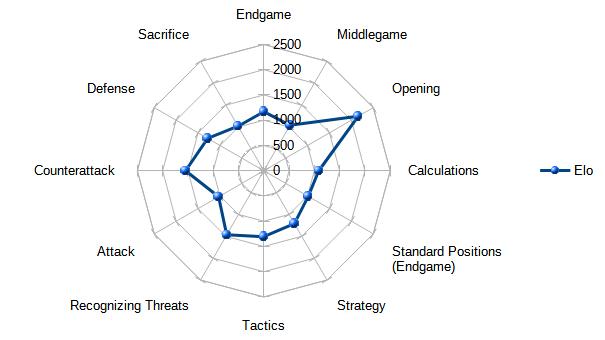
Stadlbauer
Maestro SchachProfessor
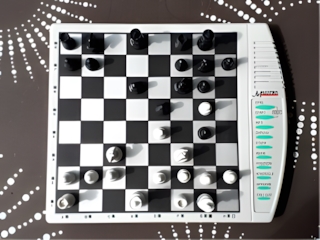
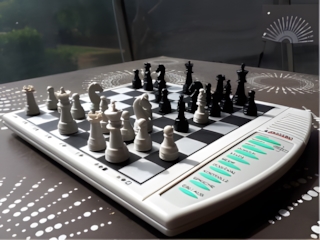 Year:
1995
Year:
1995
Programmer: Eric van
Riet Paap
CPU:
M38002M2 @4.91Mhz
ROM:
8Kb
Elo level:
1376 (1423
FIDE)
CMhz: 1.6
Rperf: 80%
Square size: 0.95"
I
discovered this small initiation electronic chessboard after
registering the Yeno 320XT for a chess computers tournament,
whose participants were expected to play under the 1400 Elo points
limit. I appreciated its rather decent playing style during the match
it won against the Yeno; and I was happy to watch playing an Eric van
Riet Paap program, it was the first time I did. I like variety of
authors and brands in my collection, two birds killed with one stone!
In addition, the singlechip 8 bits Mitsubishi micro-controller was as
well unprecedented amongst my devices, and the category deserved some
reinforcements. So, when I spotted this one on German eBay, offered for
€9.90, I didn't hesitate much. It is the only chess computer
made
by the Staldbauer company, based on an idea from Ossi Weiner (Hegener
& Glaser had just been taken over by Saitek previous year, and
he
was going to create Millennium 2000 on the next year, with
Manfred Hegener as a partner). The idea was to add chess training
features to a chess computer. So, this device comes with a 75 pages
educational booklet, including 56 exercises to be practised
with
support from the computer, activated using the levels set with a to g
files. The last 8 squares from h file activate the usual playing
levels, for games facing the computer or mate search. This program,
backed up by a well stocked openings book, finds rather often
good
positional moves, with regards to its strength category; and does so
endgame included. Its main weakness is tactics, it struggles
over gaining or even keeping any material advantage. Its
playing
style, and its strengths and weaknesses as well, remind me of the
Systema Challenge, with that one exception you will find the Challenge
two categories ahead... But a decent positional play and limited
tactical strength seem to be a smart choice for an initiation chess
computer. I point out this device speaks German, using a limited
vocabulary (that can be replaced by beeps), and the training booklet is
as well only available in German language.
Scisys Sensor Chess + SPM

 Year:
1982
Year:
1982
CPU:
6502 @2Mhz
ROM:
4+2Kb
Elo level:
1399 (1441
FIDE)
CMhz: 2
Rperf: 80%
Square size: 0.99"
I
discovered the nice playing style of Kaplan/Barnes programs using the
below Chess
Companion III. Then I bought stronger with the Tandy 2150. I was
curious about playing an older and smaller program version (the chess
computer was launched in 1981, but the inserted Strong
Play Module dates from 1982). I like the design, it is a pretty device
featuring a led for each square, and the leds are magnificently
integrated, being level with the board overlay. The whole device is a
bit heavy and bulky, especially the original mains adaptor.The
overlay has suffered some marks of usage and tends to stick out,
mainly around the module place. Nothing unexpected with regards to the
age for a chess computer that was offered for €39.90, complete
including original package, manual, mains adaptor, chessmen and the
Strong Play Module. An additional motivation for buying was my will
to populate more the next playing strength category, that fits me
well. Actually the Sensor Chess rating fluctuates between the low limit
of this target category, and the high limit within this current
one; thanksfully the module
helps a bit. Despite a quite strong computing power regarding the
category, Sensor Chess can quite easily be caught in tactical schemes,
thus revealing a limited tree search. Its strength appears to be
related to chess patterns knowledge (no doubt J.Kaplan's
mark),
basic but efficient: forks, pins, masked attacks, opened lines...
Chessmen it tries to jointly make active are quite well coordinated.
Talking about user experience, diods are perfect but the push-sensitive
squares and panel keys require too much pressure before reaction; and
sound management is a bit odd: a bip confirms both from and to-squares
recording, on player's move, while on computer move, the single
from-square gets a bip for confirmation, and the player must rely on
the square diod lighting off to make sure the to-square has been input.
As chessboard sensitivity is not great, a second bip would have cleared
any doubt.

 Year:
1982
Year:
1982
 Year:
1987
Year:
1987


 Year:
1979
Year:
1979
 Year:
1979
Year:
1979














